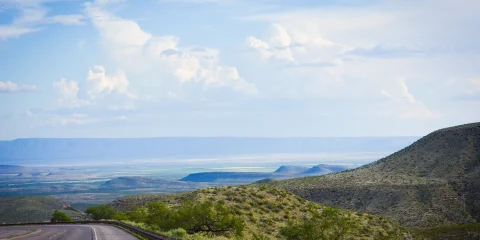Toll Roads vs. Free Roads in Mexico: The Ultimate Guide to Choosing the Best Route, Sanborns Mexico
By Cyndi Wright |

Toll Roads vs. Free Roads in Mexico: Making the Best Choice for Your Journey
When planning a road trip in Mexico, one of the most important decisions you’ll make is whether to drive on toll roads (cuotas) or free roads (libres) – or maybe a combination of both. These options come with pros and cons, and understanding the differences can help you make the best choice for your journey.
Whether you’re looking to save time, reduce costs, or enjoy a more scenic drive, this guide will break down the benefits and drawbacks of each option. And before you hit the road, don’t forget to ensure you have Mexico auto insurance, which is essential for safe travel on both toll roads and free roads. Let’s dive in!
Navigating the Roads of Mexico: An Introduction
Before you hit the road, it’s good to know what to expect on Mexico’s highways. The country offers a mix of toll roads in Mexico and free roads, both of which can get you where you need to go. Toll roads are usually quicker and smoother, while free roads are easier on the wallet and offer a more scenic look at local life. Each option has its perks, so understanding your priorities will help you make the right choice for your road trip in Mexico.
Importance of Choosing Wisely for Travelers
Choosing the right route can make a big difference, whether you are traveling in a group or planning a solo trip. A little planning can save you time, money, and hassle while allowing you to experience the full range of Mexican roads—whether you’re cruising down a smooth Mexican toll road or taking in the charm of a free, but possibly bumpy, route.
By understanding what each road type offers, you can tailor your journey to your preferences, whether that’s speed, scenic beauty, local flavor or cost savings. With a little foresight, you can enjoy both convenience and adventure as you navigate through Mexico.
Cruising on Cuotas: Unveiling Mexico’s Toll Roads
Arriving at your destination quickly and easily sounds like a dream, right? Well, it can actually be a reality! Toll roads in Mexico, or cuotas, are a fast and smooth way to travel, perfect if you’re looking to get where you’re going without delays. These roads are usually in good shape, with clear signs and well-maintained surfaces and they’ll get you to the doorstep of some of the best cities to visit in Mexico. Of course, there are a few trade-offs, so let’s take a look at what you need to know about toll roads in Mexico.
Costs and Payment Methods on Mexico’s Cuotas
Toll roads vs free roads—when it comes to toll roads, you’ll need to pay the toll at various toll booths along the way. The cost varies depending on the road and distance, so some routes might be pricier than others. But for many travelers, the faster travel time and fewer detours make them worth it!
You’ll usually pay the toll in cash, but many toll booths now accept credit cards, making the process much more convenient, especially for visitors. If you’re renting a car, it’s a good idea to check with the rental agency to see if your car has any electronic toll payment options or if cards are accepted. And just to be on the safe side, make sure to have some Mexican pesos with you—especially in more remote areas where cards might not be an option. Many gas stations along the way can also help with any refueling needs.
Exploring via Libres: Embracing the Free Roads
On the other hand, Mexico’s free roads (libres) offer a toll-free, often more scenic alternative. While libres can save you money, they do come with a few challenges. Free roads are often single lane, which can slow down traffic, especially in rural areas or during busy travel times. Road conditions can vary, with some parts well-paved and others more rugged, with topes (speed bumps) and even livestock crossing.
These roads can also pass through small towns, which adds some charm but can also slow you down due to local traffic. While libres are less predictable, they provide an authentic experience of Mexico’s rural areas, something you might miss if you stick solely to the Mexican toll roads.
Safety First: Assessing the Conditions of Toll and Free Roads
When driving in Mexico, safety is key. Toll roads in Mexico are generally well-maintained, so they offer smoother, more predictable driving. However, don’t assume they are completely risk-free. Road conditions can change, and construction zones or temporary closures are not uncommon, especially on long-haul journeys.
Free roads can be more unpredictable in terms of maintenance. Some libres are well-paved, while others might have surprisingly big topes, potholes, or loose gravel.
Taking the time to learn how to read some basic road signs in Mexico may go a long way to helping you decide when its time to get off the toll and explore or vice versa – find the nearest toll and miss local construction.
All roads in Mexico can be poorly lit at night, so be extra cautious when driving there after dark. Always stay alert, particularly when navigating through rural areas where hazards like livestock crossing may pop up unexpectedly.
Trip Planning: Calculating Time and Budgeting Costs
When choosing between toll roads vs free roads, the decision often comes down to time versus cost. If you’re looking to get to your destination as quickly as possible, toll roads in Mexico are your best bet. They’re generally faster, with fewer stops and better road conditions for covering long distances.
If you’re on a tighter budget, libres offer a more economical route, though you may face more delays. Consider checking apps like Caminos y Puentes Federales for real-time updates on road conditions and toll costs, helping you plan your route more effectively.
Getting the Best of Both Worlds: Mixing Cuotas and Libres
Why choose one when you can have both? Many travelers opt to combine toll roads vs free roads to strike a balance between speed and savings. You might start your journey on a toll road to cover the longer, busier stretches and then switch to free roads for the more scenic part of your drive, especially when you’re getting closer to your destination.
Strategies for an Efficient Route that Combines Toll and Free Roads
Here’s how you can make the most of both toll roads vs free roads by combining the benefits of each. By mixing routes, you can save time, enjoy scenic drives, and still keep your budget in check. Here are some tips for planning a mixed route:
- Start with a toll road to cover the longer, busier stretches of your journey.
- Switch to free roads once you’re closer to your destination or in more rural areas.
- Use navigation apps like Google Maps or Waze to help plan a mixed-route journey.
- Consider the time savings on toll roads when you want to avoid delays in larger cities.
This approach can help you save time on long stretches while still giving you the chance to experience the scenic side of Mexico.
Ready To Get A Quick Quote?

